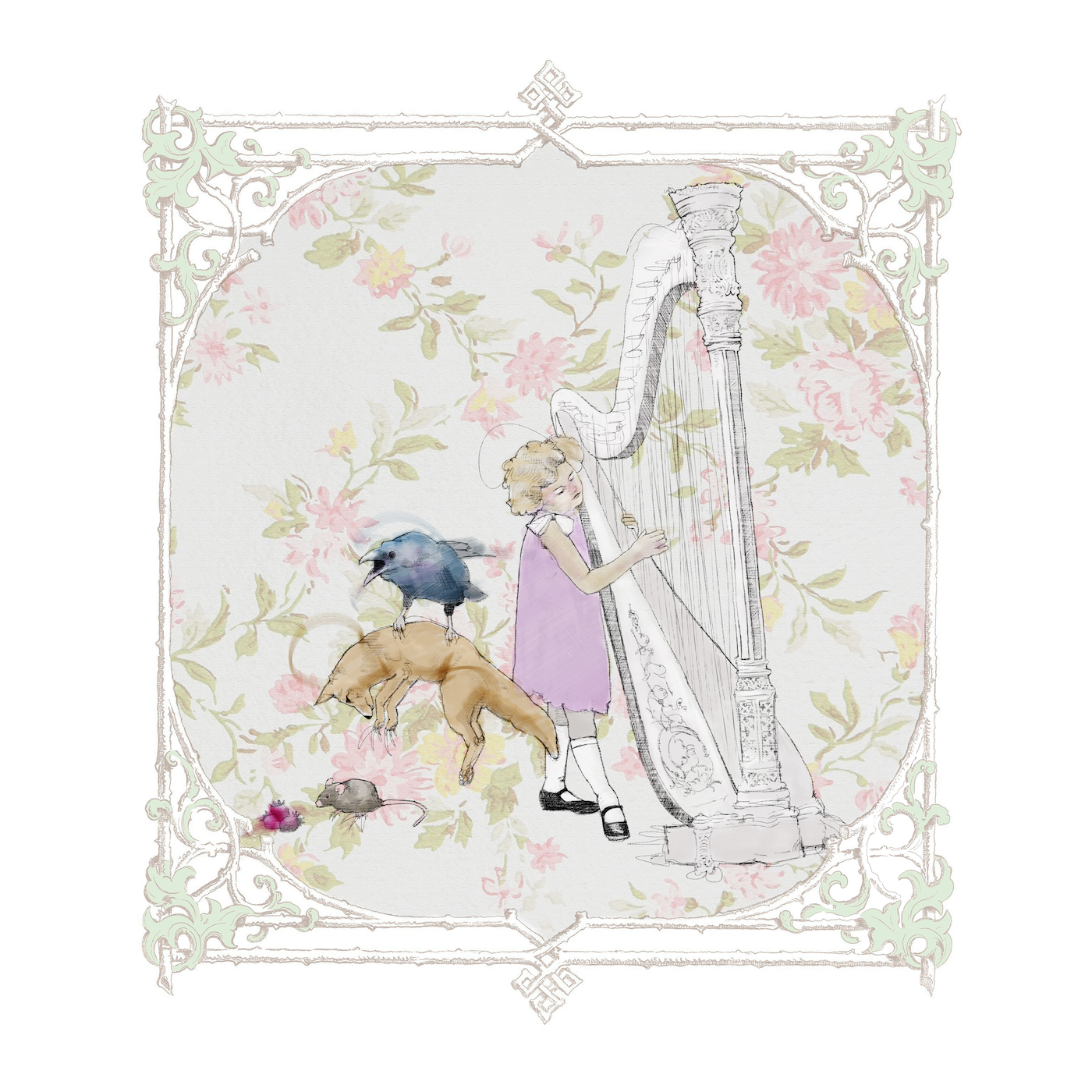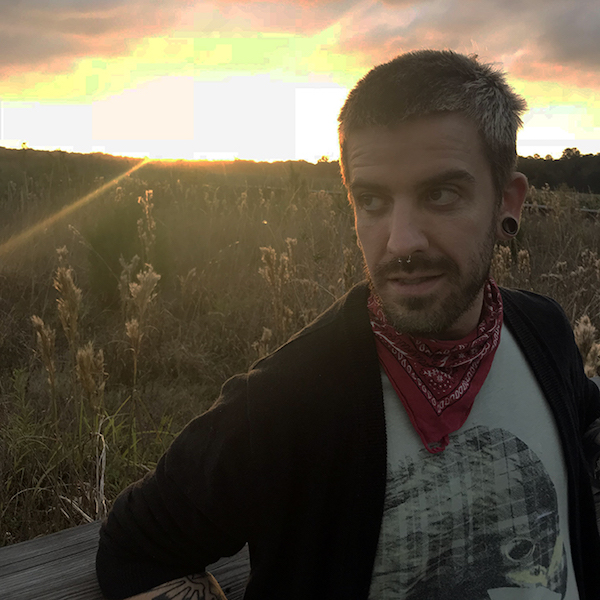Guest Album Review – “Ys” by Joanna Newsom
This guest review was originally part of a music blog project I created called Under The Deer. Since that site won’t be around forever, I’m archiving these wonderful reviews and their accompanying illustrations here. Writer and illustrator listed at end of the review.
When it comes to music, it seems that everyone’s a critic, even with near-perfect albums like Joanna Newsom’s 2006 Ys (pronounced eees or yeeesh). This 5-track, exquisitely crafted work by the singer-songwriter-harpist not only holds its own as an outstanding example of her artistic fortitude; the addition of a full-piece orchestra (arranged by Van Dyke Parks) creates the kind of aural opulence rarely achieved in any musical context, let alone via a squeaky-voiced, 20-something folk harpist.
While for the most part, the album was highly acclaimed, people have accused the album – and by extension, Newsom – of being self-indulgent, which begs the question: What creative masterpiece isn’t a little self-indulgent? If creativity stems from deep reflection, imaginative courage, and, yes, probably some emotional neuroses, it must, by definition, be self-indulgent.
But what makes a great piece of art is its ability to reach the audience. And while this album may, at first, seem a little bit “out there” (at least lyrically), one only has to listen for a moment to understand its depth. It is rife with purpose, both thematically and in the way it shows Newsom’s mastery as a poet and musician.
Ys transports us to other lands–the sky, the sea, the forest–then it sweeps us back home again, a thematic rhythm echoed through composition: we’re away, and she’s almost lost us (but it’s still fascinating), and suddenly we’re right back with her again.
We’re perplexed…we get it.
We’re adrift…we’re grounded.
We’re dreaming…we’re awake.
And so go the undulations of time, love, loss.
Ys is an otherworldly album, lyrically, structurally and aurally. It is at once not of this earth and incredibly relatable. Her inner journey is strange, each verse turning a new corner with unusual imagery. It’s an open invite.
Newsom is not trying to be “abstract;” she just wants us to listen.
Each song pulls us along through intricate adventures accentuated by deliberate pacing and cadence. Orchestral breaks allow us to rest and then listen more closely to lyrics, with one of the first notable gaps highlighted by a pared-down tempo in Emily:
You came and lay a cold compress upon the mess I’m in
Threw the window wide and cried, “Amen! Amen! Amen!”
The whole world stopped to hear you hollering
You looked down and saw now what was happening.
The lines are fading in my kingdom
(Though I have never known the way to border them in).
Here we again are brought from some wild outdoor spectacle and into a scene so simple it’s almost pastoral: she’s in a room, sick in bed, her sister at her side. It’s a vulnerable moment that reminds us that she is not an ethereal, otherworldly being: she is mortal. She’s just like us.
And she wants us to know her.

The album continues to wax and wane through crescendos (and diminuendos), always moving, often dramatic. Every verse turns a corner into a new scene, and this happens so frequently that it’s hard to keep up, but not in a bad way. Ys is a cozy blanket, a bizarre adventure, a wise tale, an intricate dance.
Some critics balk at her voice, and it’s true that it’s not easy at first. But it’s so unabashedly raw that we must take it as is. As something both childlike and urgent, it’s integral to her tapestry. And we have to remember that she is, after all, a harpist and storyteller who is using her voice as an instrument. It’s a good reminder of how important it is to listen to the heart behind the voice.
Sawdust and Diamonds is equally as entrancing as the rest of the album, but without orchestral backing, it’s fine proof of how well she can hold her own, of that unearthly space she occupies as both artist and human. It’s the kind of thing that makes us believe in the muse, wondering at every turn, “where the hell does she come up with this?” and keeping us fascinated as we join her in that other place and time.
Her ability to lead us through shifting landscapes with such ease is clear once we get to Sawdust, where she is a lost mariner where the bell, “tolls for thee,” on her way back to shore. She returns from the shifty, uncertain time and back to her love, despite their relationship being as fleeting as “a sandcastle that the gibbering wave takes.”
A particular image stands out towards the end of the song, as something that seems so much like her: a doe-eyed, delicate creature born with innate wisdom. This creature is tenacious, awake, yet somehow unable to escape the burden of love that defines us as humans.
I wasn’t born of a whistle or milked from a thistle at twilight
No I was all horns and thorns sprung out fully formed, knock-kneed and upright.
So: enough of this terror, we deserve to know light
And grow evermore lighter and lighter
You would have seen me through
But I could not undo that desire
The fourth song, the 16-minute Only Skin, carries us through spectacular orchestral arrangements which illustrate sharp emotional landscapes. As with her other songs, each verse is more resplendent than the last. The delicate integration of poetic structure, vocal cadence, tempo changes and signature shifts work with the music to fly us from ocean to cabin to prairie. We are next to our lover, then distant; yearning, then content; alone, then connected.
Press on me,
we are restless things.
Webs of seaweed are swaddling.
And you call upon the dusk of the
musk of a squid:
shot full of ink, until you sink into your crib.
Rowing along, among the reeds, among the rushes,
I heard your song, before my heart had time to hush it!
Smell of a stone fruit being cut and being opened.
Smell of a low and of a lazy cinder smoking
And when the fire moves away,
fire moves away, son.
Why would you say
I was the last one?
This is not just any old album: it’s a story, a painting, a world unto its own. It’s a richly bittersweet testament to the temporary nature of all that is life, and thank goodness we have the pleasure of experiencing Ys again and again. In its warmth and complexity, Ys reveals more each time we give it a listen, perhaps akin to the kind of relationship most could only dream of.
Contributors

Renée Picard is a freelance writer-editor who leads life with a soft-but-fierce heart.

Jonathan M James In a single brushstroke Jonathan blends the familiar and the grotesque to create an abstraction that defines the complexity of the human experience; often resulting in an isolated element that exists in a single moment.